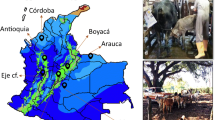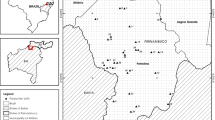Abstract
The present study was designed to investigate the prevalence of the pathogenic coccidia species E. bovis and E. zuernii in shed-reared animals in German dairy and fattening facilities.
Samples were obtained from 65 cattle farms distributed randomly across all the regions of Germany, regardless of the occurrence of clinical problems. The samples were obtained rectally. Faecal consistency and the total number of oocysts per gram of faeces (OPG) were determined for Eimeria spp., along with the separate OPG values for Eimeria (E.) bovis and E. zuernii. A questionnaire was completed for each farm to record information about herd size and management together with individual animal data.
Eimeria oocysts, regardless of the kind of Eimeria spp., were detected in 62 of these farms, which gives a prevalence of 95.4 %. The farm prevalence of the pathogenic species was 76.9 % for E. bovis and 83.1 % for E. zuernii. The average oocyst excretion level was 2,950 OPG in terms of total Eimeria spp. oocyst excretion, 700 OPG for E. bovis and 1,500 OPG for E. zuernii.
The number of oocysts excreted could not be correlated significantly with farm type or farm management but depended on the floor type which influences the infection pressure, on the age of the calves and the time after rehousing. In general, higher oocyst excretion rates were found in calves kept on litter compared to rearing on slatted floor. Younger calves and calves sampled early after housing shed higher amounts of oocysts than older calves and calves stabled a longer period before sampling, respectively. Furthermore, there was a positive correlation between OPG and the observation of diarrhoea, defined as observation of a loose to liquid faecal consistency. Excretion of E. zuernii oocysts was more closely linked to the occurrence of diarrhoea than E. bovis oocyst excretion. This study confirms that the pathogenic coccidia E. bovis and E. zuernii are ubiquitous in German cattle populations and a significant cause of diarrhoeal disease in calf rearing.
Similar content being viewed by others
References
Bangoura B, Daugschies A (2007) Parasitological and clinical parameters of experimental Eimeria zuernii infection in calves and influence on weight gain and haemogram. Parasitol Res 100(6):1331 – 1340.
Cotteleer C, Famerée L (1978) Bovine Eimeria in Belgium. Incidence and identification. (Article in French) Schweiz Arch Tierheilkd 120(3):149 – 156.
Daugschies A, Böse R, Marx J, Teich K, Friedhoff KT (2002) Development and application of a standardized assay for chemical disinfection of coccidia oocysts. Vet Parasitol 103:299 – 308.
Daugschies A, Staschen S, Mundt H-C (2005) Eimeria zuernii coccidiosis in a large cattle herd. Bull Scand-Baltic Soc Parasitol 14:46.
Daugschies A, Najdrowski M (2005) Eimeriosis in cattle: current understanding. J Vet Med B Infect Dis Vet Public Health 52(10):417 – 427.
Daugschies A, Agneessens J, Goossens L, Mengel H, Veys P (2007) The effect of a metaphylactic treatment with diclazuril (Vecoxan) on the oocyst excretion and growth performance of calves exposed to a natural Eimeria infection. Vet Parasitol 149(3 – 4):199 – 206.
Ernst JV, Benz GW (1986) Intestinal coccidiosis in cattle. Vet Clin North Am Food Anim Pract 2:283 – 291.
Faber JE, Kollmann D, Heise A, Bauer C, Failing K, Bürger HJ, Zahner H (2002) Eimeria infections in cows in the periparturient phase and their calves: oocyst excretion and levels of specific serum and colostrum antibodies. Vet Parasitol 104(1):1 – 17.
Fitzgerald PR (1980) The economic impact of coccidiosis in domestic animals. Adv Vet Sci Comp Med 24:121 – 143.
Gräfner G, Graubmann HD, Kron A (1978) About the epizoology of cattle coccidiosis in raising and fattening farms. Mh Vet Med 33:910 – 912.
Gräfner G, Graubmann HD, Schwartz K, Hiepe T, Kron A (1985) Further studies on the incidence, epidemiology and control of bovine Eimeria coccidiosis under intensive-rearing conditions. (Article in German) Mh Vet Med 40:41 – 44.
Gulliksen SM, Jor E, Lie KI, Hamnes IS, Løken T, Akerstedt J, Osterås O (2009) Enteropathogens and risk factors for diarrhea in Norwegian dairy calves. J Dairy Sci 92(10): 5057 – 5066.
Haschek B, Klein D, Benetka V, Herrera C, Sommerfeld- Stur I, Vilcek S, Moestl K, Baumgartner W (2006) Detection of bovine torovirus in neonatal calf diarrhoea in Lower Austria and Styria (Austria). J Vet Med B Infect Dis Vet Public Health 53(4):160 – 165.
Hiepe T, Romeyke D, Jungmann R (1978) Studies of coccidia infections in calves under intensive rearing conditions and recommendations for their control. (Article in German) Mh Vet Med 33:904 – 910.
Kemper N, Henze C (2009) Effects of pastures’ re-wetting on endoparasites in cattle in northern Germany. Vet Parasitol 161(3 – 4):302 – 306.
Klockiewicz M, Jaba J, Tomczuk K, Janecka E, Sadzikowski AB, Rypula K, Studzinska M, Malecki-TePicht J (2007) The epidemiology of calf coccidiosis (Eimeria spp.) in Poland. Parasitol Res 101:121 – 128.
Jäger M, Gauly M, Bauer C, Failing K, Erhardt G, Zahner H (2005) Endoparasites in calves of beef cattle herds: management systems dependent and genetic influences. Vet Parasitol 131(3 – 4):173 – 191.
Joachim A (2002) Coccidiosis also exists in calves. (Article in German) DLZ Agrarmagazin 8:92 – 94.
Lassen B, Viltrop A, Järvis T (2009a) Herd factors influencing oocyst production of Eimeria and Cryptosporidium in Estonian dairy cattle. Parasitol Res 105(5):1211 – 1222.
Lassen B, Viltrop A, Raaperi K, Järvis T (2009b) Eimeria and Cryptosporidium in Estonian dairy farms in regard to age, species, and diarrhoea. Vet Parasitol 166(3 – 4):212 – 219.
Lentze T, Hofer D, Gottstein B, Gaillard C, Busato A (1999) Prevalence and importance of endoparasites in calves raised in Swiss cow-calf farms (Article in German.) Dtsch Tierarztl Wochenschr 106(7):275 – 281.
Mundt H-C, Daugschies A, Uebe F, Rinke M (2003) Efficacy of toltrazuril against artificial infections with Eimeria bovis in calves. Parasitol Res 90 (Suppl 3):166 – 167.
Mundt H-C, Bangoura B, Mengel H, Keidel J, Daugschies A (2005) Control of clinical coccidiosis of calves due to Eimeria bovis and Eimeria zuernii with toltrazuril under field conditions. Parasitol Res 97 (Suppl 1):134 – 142.
Pilarczyk B, Ramisz A, Jastrzfbski G (2002) Internal parasites of cattle in select Western Pomerania farms. (Article in Polish with English abstract) Wiad Parazytol 48(4):383 – 390.
Raynaud JP, Mage C, Le Stang JP (1981) Major internal parasites interfering with cattle production in France, and experiments to control them by strategic treatments. A bibliographic review. Ann Rech Vet 12(2):143 – 157.
Stewart ID, Smith RP, Ellis-Iversen J (2008) Eimeria species in cattle on farms in England and Wales. Vet Rec 162(15):482 – 483.
Stockdale PHG, Bainborough AR, Bailey CB, Niilo L (1981) Some pathophysiological changes associated with infection of Eimeria zuernii in calves. Can J Comp Med 45:34 – 37.
Supperer R (1952) The coccidia of cattle in Austria. (Article in German) Oesterr Zool Zschr 3:591.
Thienpont D, Rochette F, Vanparijs OFJ (1990) Diagnose von Helminthosen durch koproskopische Untersuchung. Janssen Pharmaceutica, Beerse.
Wacker K, Roffeis M, Conraths FJ (1999) Cow-calf herds in eastern Germany: status quo of some parasite species and a comparison of chemoprophylaxis and pasture management in the control of gastrointestinal nematodes. Zentralbl Veterinarmed B 46(7):475 – 483.
Author information
Authors and Affiliations
Corresponding author
Rights and permissions
About this article
Cite this article
Bangoura, B., Mundt, HC., Schmäschke, R. et al. Prevalence of Eimeria bovis and Eimeria zuernii in German Cattle Herds and Factors Influencing Oocyst Excretion. Parasitol Res 109 (Suppl 1), 129–138 (2011). https://doi.org/10.1007/s00436-011-2409-1
Published:
Issue Date:
DOI: https://doi.org/10.1007/s00436-011-2409-1




